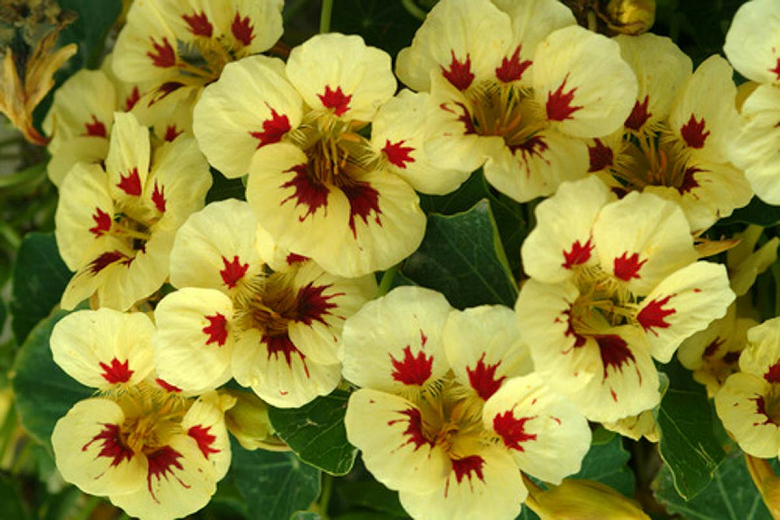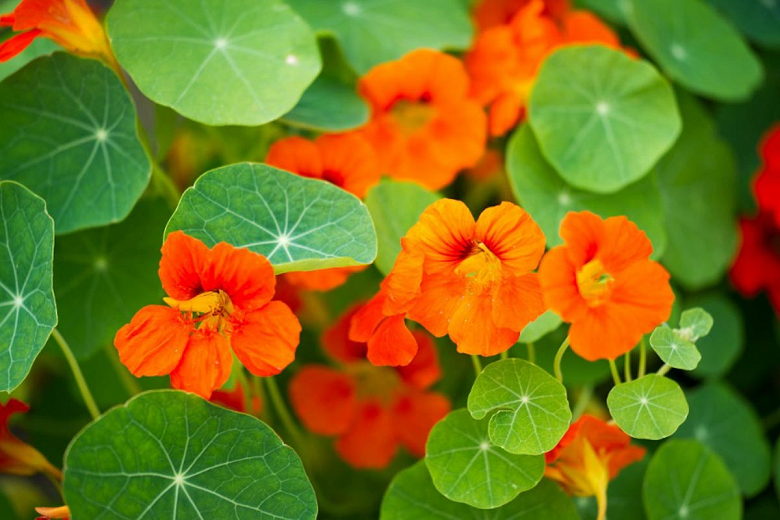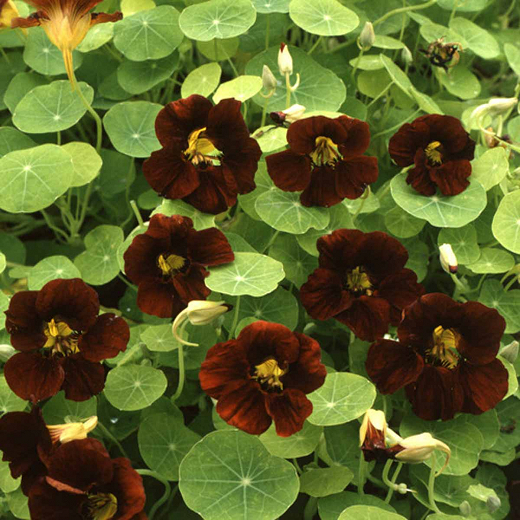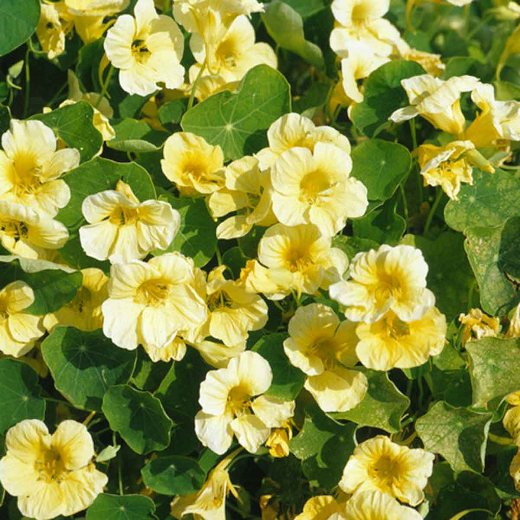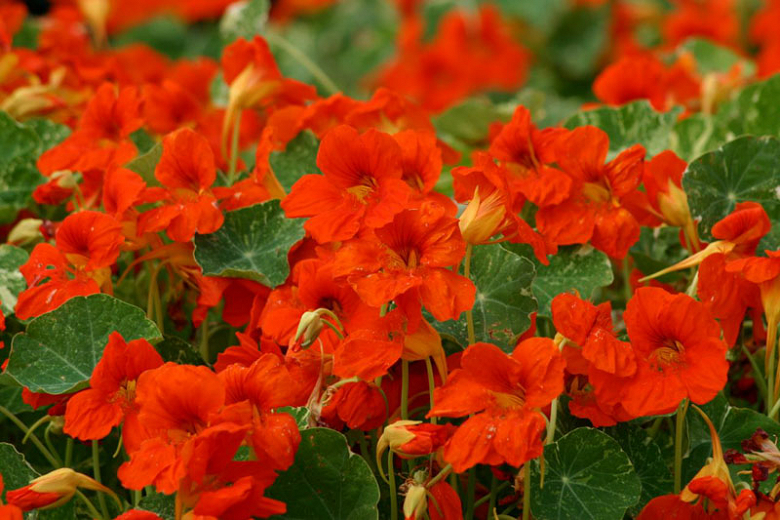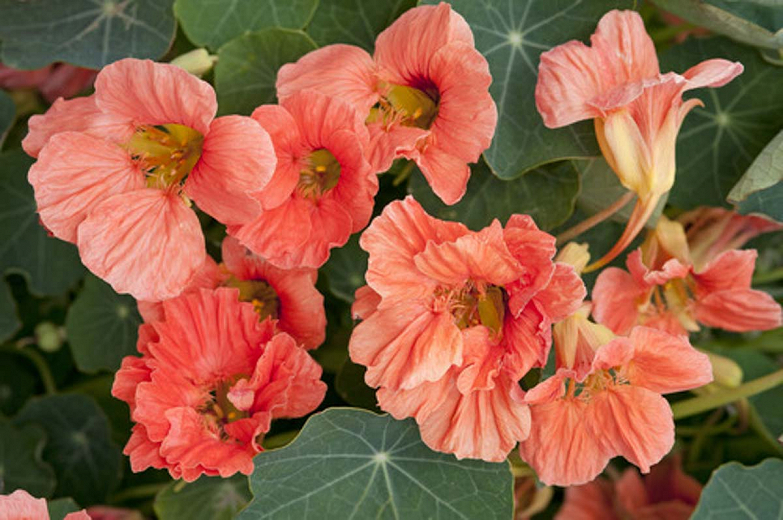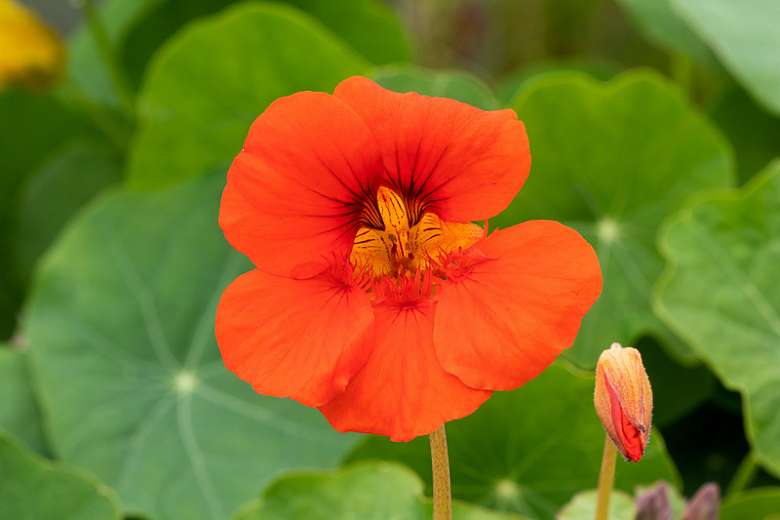Tropaeolum minus Ladybird Cream Purple Spot (Nasturtium)
Eye-catching, Tropaeolum minus ‘Ladybird Cream Purple Spot’ (Nasturtium) is a compact, bushy annual or short-lived perennial forming a small mound of rounded, parasol-like, dark green leaves. Blooming from winter through spring in mild winter areas and from summer to fall in colder climates, it boasts a profusion of long-stalked, funnel-shaped, creamy-yellow flowers adorned with raspberry-purple spots.
Eye-catching, Tropaeolum minus 'Ladybird Cream Purple Spot' (Nasturtium) is a compact, bushy annual or short-lived perennial forming a small mound of rounded, parasol-like, dark green leaves. Blooming from winter through spring in mild winter areas and from summer to fall in colder climates, it boasts a profusion of long-stalked, funnel-shaped, creamy-yellow flowers adorned with raspberry-purple spots. The blossoms make a fantastic contrast to the dark foliage. This petite Nasturtium is ideal for containers and small space gardens.
- Grows up to 12 in. tall and wide (30 cm).
- Thrives in full sun in poor, well-drained soils. Some afternoon shade is appreciated in hot summer areas. Rich, fertile soils are not recommended as they yield more foliage but reduce flowering. Drought-tolerant once established.
- Nasturtium is perennial in hardiness zones 9-11 and grown as an annual plant elsewhere. It relishes cooler temperatures (in the 70sºF or 20sºC) and often sulks in extremely dry or humid conditions.
- Nasturtium is versatile and can be used in beds and borders, rock gardens, edgings, as a ground cover, or in mass plantings.
- It adds a touch of old-fashioned charm in herb gardens, cottage gardens, or patio containers.
- Nasturtium is also an excellent choice to mix with spring-flowering bulbs since it can effectively hide the unattractive bulb foliage that may be allowed to mature.
- Bees, butterflies, hummingbirds, and other pollinators are drawn to the flowers, making Nasturtium a valuable addition to the vegetable garden.
- Nasturtium is a good companion plant for beans, broccoli, cabbage, cucumber, kale, melon, pumpkin, and radish.
- Nasturtium can also be used as a trap crop, trapping pests such as aphids and giving a more appealing and delicious meal than nearby vegetable crops.
- Nasturtiums rank among the most common edible flowers. The delicate blossoms have a sweet, peppery taste similar to watercress. Leaves and unripe seed pods add a citrusy and peppery flavor to salads. Flower buds contain mustard oil and may be used for seasonings. The flowers add eye-catching beauty to the plate and can be used to garnish salads, platters, and savory dishes.
- Few insects or diseases bother Nasturtiums. Watch for blackflies (black aphids), caterpillars, flea beetles, slugs, and glasshouse whiteflies. Deer resistant.
- Deadhead to prolong flowering.
- Propagate by seed. Sow seeds outdoors after all danger of frost has passed or indoors 4-6 weeks before the last spring frost date.
- Avoid fertilization, which tends to increase foliage and decrease flowering.
- Nasturtium will self-seed, keeping a presence in the garden.
- Tropaeolum minus is native to Central and South America.
- Nasturtium is toxic to dogs, cats, and horses.
Requirements
| Hardiness | 2 – 11 |
|---|---|
| Heat Zones | 1 – 12 |
| Climate Zones | 1, 1A, 1B, 2, 2A, 2B, 3, 3A, 3B, 4, 5, 6, 7, 8, 9, 10, 11, 12, 13, 14, 15, 16, 17, 18, 19, 20, 21, 22, 23, 24, A1, A2, A3, H1, H2 |
| Plant Type | Annuals |
| Plant Family | Tropaeolum – Nasturtiums |
| Exposure | Full Sun, Partial Sun |
| Season of Interest | Summer (Early,Mid,Late)Fall |
| Height | 1' (30cm) |
| Spread | 1' (30cm) |
| Spacing | 12″ (30cm) |
| Water Needs | Average |
| Maintenance | Low |
| Soil Type | Chalk, Loam, Sand |
| Soil pH | Acid, Alkaline, Neutral |
| Soil Drainage | Well-Drained |
| Characteristics | Cut Flowers, Showy |
| Tolerance | Deer, Drought |
| Attracts | Bees, Butterflies, Hummingbirds |
| Garden Uses | Beds and Borders, Edging, Ground Covers, Hanging Baskets, Patio and Containers, Small Gardens, Walls and Fences |
| Garden Styles | City and Courtyard, Gravel and Rock Garden, Informal and Cottage |
